
Chinmaya Naada Bindu’s Rama Darshan in dance and music
Text & pics: Lalitha Venkat
e-mail: lalvenkat@yahoo.com
October 6, 2011
The 2nd Naada Bindu Festival for the Arts took place in Chennai on
October 1 and 2, 2011. The Chinmaya Heritage Centre in Chennai
generously supported this festival, by sponsoring their premises for a
month of stay and rehearsals and auditorium for performance. Focused on
the Ramayana, Rama Darshan featured classical dances from India and
Indonesia, music from Southern and Northern India, shadow puppetry and
free educational lecture-workshops. Ramaa Bharadvaj, the brain behind
the concept and direction of the show, envisioned day one of the fest to
include movement art forms and day two to feature music forms.
The first evening of the fest started with an invocation song sung by
renowned musician Sriram Parasuram. In keeping with the theme of the
fest, he aptly chose “Ram ka gun gaan kariye” and he was also clad in a
kurta that was almost saffron in color! Chief guest N Murali spoke about
the timelessness of the epic, how the Ramayana has crossed barriers of
art forms and the inextricable link between art and spirituality. Swami
Tejomayananda made a short and sweet speech. “Rama’s life is open to all
of us to view, understand and interpret as we like. The final outcome
should be that we should grow in love for him.”
Click on thumbnails to view enlarged images
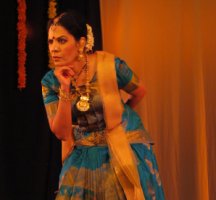
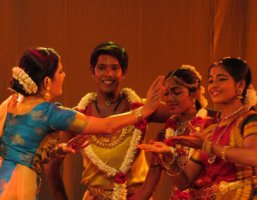
The first program of the evening was ‘Ram Katha’ choreographed and
presented by Ramaa Bharadvaj along with youngsters Lakshminarayan, N
Varsha and Ashrita Keshav in Bharatanatyam style. The sequence covered
Bala Kandam to Ayodhya Kandam, from Rama’s birth to his
banishment. The accompanists were Kritika Arvind on vocal, Anil
Kumar on mridangam and Srilakshmi on violin.
Clad in a beautiful turquoise and gold costume, Ramaa began with an
invocation she had created specially for the festival in collaboration
with acclaimed music composer Rajkumar Bharathi. The words were taken
from Nama Ramayana. At the end of the item, it was interesting to note
that the floral offerings were laid before the idols of Rama, Sita,
Lakshmana and Hanuman kept on one side of the stage. Sita and her sakhi
spend time happily in the garden when they happen to set eyes on Rama.
Both wonder about the other’s identity. In a dramatic moment, Sita runs
to Rama and they look at each other, before the sakhi drags her away. As
in a flashback, the sakhi narrates the important incidents from Bala
Kandam – Rama is the son of Dasaratha, king of Ayodhya, Rama destroys
the demons who come to obstruct Vishwamitra’s yagna and Ahalya is
redeemed of her curse by Rama.
Enters Ramaa Bharadvaj again and plays multiple roles, giving the call
for the swayamvaram by beating the drum. Instead of the predictable
scene of would be suitors trying to lift the bow and failing, Ramaa
chose to depict the thoughts of the suitors, wise men and audience
gathered at the swayamvaram, with verses from Tulsidas. The competitors
wonder how the young man with pretty face is going to lift that heavy
bow. To the brave contestants, he seemed like an amazing warrior (veera
rasa); to the demons as princes in disguise, he seemed like Yama
(bhayanaka rasa); to the wise sages, he appeared as a radiant cosmic
form (adhbuta rasa); to King Janaka’s wife, he seemed like a child
(vatsalyam); and to Sita, he appeared as a lover (shringara rasa).
Finally, Rama lifts the bow and wins the challenge.
The next scene shows Rama and Sita getting married in south Indian style
with a charming oonjal sequence. The wedding celebration takes the form
of a happy thillana by the couple before Ramaa enters again and plays
the three roles of the scheming Manthara, and the petulant Kaikeyi
demanding her two boons from the hapless Dasaratha. Dialogues taken from
Kamba Ramayanam were used here to good effect. Ramaa’s angika and
vachika abhinaya and facial expressions changed rapidly and admirably as
she got into each character’s role. This little group of 4 dancers
managed to convey the story well through well edited sequences and
evocative choreography.
Kaikeyi stands firm demanding the banishment of Rama. In a master stroke
of direction by Ramaa, the Balinese dancers portraying the trio walk
along the rear of the stage into the forest, smoothly transferring into
the next dance style and Aranya Kandam. The Ramayana happened in India
and the epic then spread across Indonesia and other countries, hence the
Bala Kandam and Ayodhya Kandam were done in Indian dance style and the
Aranya Kandam in Balinese style, says Ramaa.
Click on thumbnails to view enlarged images
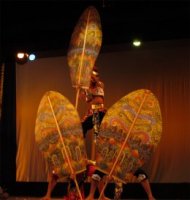
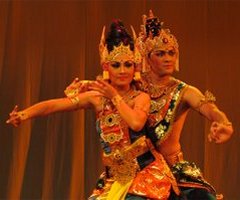
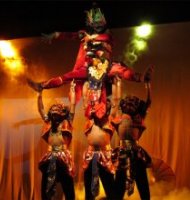
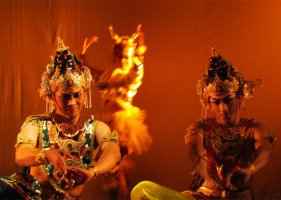
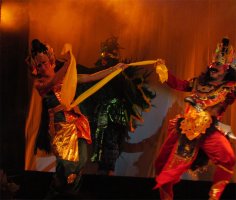
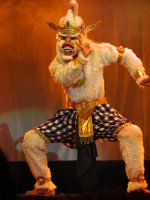
Huge leaf shaped painted props carried by the dancers made for a forest
atmosphere. The pretty Surpanaka flirts with Lakshmana and gets her nose
cut. She runs to complain to her brother Rahwana / Ravana (P
Anggaradana Suka) whose very entry was dramatic, held aloft by his
subjects. In a sprightly scene, the golden deer weaves in and out among
the trio and runs away. After Rama goes in search of the deer and
Lakshmana also leaves, we see Ravana trying to get near Sita but a
strong force does not allow him to. The transformation of Ravana into
the sage was done beautifully with the huge leaf hiding the sage behind
it and with the twisting around of the leaf, Ravana goes behind it and
the sage moves to the front. After abducting Sita, the sage transforms
again into Ravana in the same theatrical manner. In the meantime, Rama
shoots an arrow (he really did!) and kills Maricha. The Jatayu - Ravana
confrontation sequence was as colorful and striking; Rama and Lakshmana
then do the last rites for the slain bird.
Hanuman (I Ketut Gede Agus Adi Saputra) enters in a white costume, and
does a somersault into the hearts of the audience. Rama gives his ring
to be given to Sita. She is sitting sadly at Ashokavanam with the good
hearted rakshasi Trijata who begs Ravana to be patient with Sita. The
Ravana character wears a mask but his very demeanour betrays his
lecherous intentions. Hanuman gives the ring to Sita, a brief battle
ensues and in a grand finale, Rama is held aloft in a human pyramid
declaring him the victor.
The selection of artistes was very good, as the serene Rama (AA Gede
Rahma Putra), the bashful Sita (Ni Putu Diah Yeti Mahayani) and the
faithful Lakshmana (I Wayan Plong Widiana) really looked their part.
Ravana’s very body language through the program was majestic and
powerful, accentuated now and then by growls, somewhat like we see in
Kathakali. The other characters like Jatayu (I Putu Candra Pradita), the
sage (I Gusti Bagus Surya Prabhawa), Maricha (I Wayan Sujana) and
Surpanaka (Ni Putu Sinta Ulantari) all played their parts well. The
costumes were specially designed for the show and the special
accessories made with leather and gold paint. Choreographed by Rahma
Putra (who also played Rama), the lively performance was well edited.
The troupe of Kita Art Community from Bali worked under the guidance of
Indra Udayana (director of the Gandhipuri Ashram in Bali) and artistic
director Ketut Widi Putra.
Click on thumbnails to view enlarged images
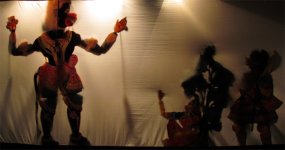
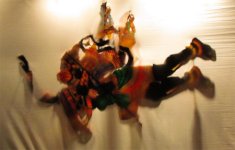
The third segment was a leather puppet show titled ‘Hanuman in search of
Sita’ by Seethalakshmi and the Indian Puppeteers Group from Chennai.
Wherever there is danger, Hanuman is there and brightly colored puppets
showed us in nataka yakshagana prabandham prevalent in Andhra, some
scenes from Kamba Ramayanam. The lyrics were in Tamil and easy to
understand. Some scenes depicted were the Vali-Sugriva fight, killing of
Vali, Rama giving Hanuman his ring to give Sita, the hospitable and
inhospitable characters like Nagadevatai and Lankini that Hanuman meets
en route to Sri Lanka, Hanuman giving Sita the ring, Rama slaying Ravana
and the rescue of Sita. Hanuman reducing in size and growing in size
was done very well. Unfortunately, the white screen was not stretched
properly and the puppets sometimes did not appear in clear
silhouette.
The evening ended with a ten minute talk session by the artistic
directors of the evening that was moderated by VR Devika, the director
of Aseema Trust. Ramaa Bharadvaj said, “When we research for a
production, we become fully educated. The characters come to life for
us. In this production, my focus was to get Valmiki, Kamban and Tulsidas
together and touch on how each of them looked at the Ramayana.
Some elements found in one Ramayana are not found in another, like the
lakshman rekha episode. In Valmiki Ramayana, Rama and Sita don’t meet.
Tulsidas says the two saw each other in the garden and fell in love.
Getting to know the regional aspects is very interesting for me.”
Indra Udayana said they first prayed to Valmiki for blessings, then they
chose the dancers and performed rituals for each character. “This
production is not totally Balinese. The original choreography was put
together specially for this show. Usually, our characters have only four
expressions with a general smile, but today Sita looked sad.
Since people from Orissa had migrated to Indonesia years back, Bali
feels closely connected to Orissa, so we have incorporated some Odissi
poses as well as a couple of finger postures inspired by Bharatanatyam.
From school up to university, we have Ramayana as part of school
curriculum. Of course, the story is a bit adapted where there is Muslim
tradition.” Balinese puppets used to be black before but now they are
colorful.
Seethalakshmi spoke of how when she was young, puppet shows were held in
the light of oil lamps or petromax light with the whole family behind
the screen. Now they have modernised the puppets as well as music to
cater to present day audience. She rues that puppet theatre is a dying
art.
The next evening was a happy musical experience of diverse concepts. In
‘Geet Katha’, Pramodini Rao (Resident director at Chinmaya Naada Bindu)
presented a beautiful musical medley of 8 bhajans in different languages
that were soothing and pleasing. The screens on either side of the
stage flashed the meaning of the songs as text with appropriate
illustrated visuals. Among her accompanists were Pt Kalinath Mishra on
tabla and Padma Shankar on violin, Chitaranjan Rao on side rhythms,
Shoba Iyer, Geeta Chakravarthy and Arun Raman on vocals.
In the Marathi song, Rama hears his own story sung by his sons Lava and
Kusha. They bring to life the very thoughts of Valmiki with their
rendering at the yagnashala. Rama embraces them but how many
know they are father and sons? In Hindi song “Thumak chalat
Ramachandra…” of Tulsidas, everyone watches the child Rama swaying
unsteadily as he is picked up by Dasaratha’s queens. Tulsidas is
thrilled with the face of Rama, which has the glory of the sun. In the
Sanskrit number by Thyagaraja, “Pavanaja….” behold the marriage
celebration of Rama and Sita. Rama, the praised son of Lord Pavana, who
with the sun and moon as his sacred eyes, is truly pleasing to the
heart. Thyagaraja eulogises Rama who was praised by Lord Shiva, who
ferries people across the ocean of samsara and is rightfully born in the
solar dynasty. “Ramanukku mannan mudi” in Tamil from Arunachala Kavi’s
Rama Natakam was next. Parasurama’s pride was thwarted by Rama, the one
who protects all. Isn’t Rama being crowned as king the best for the
welfare of all?
Rama leaves for exile. Oh, Rama, where are you taking Sita and
Lakshmana? The Oriya bhajan narrates how clouds of darkness will envelop
Ayodhya for how will people live the 14 years that Rama will be in
exile? The Gujarati song by Umashankar Joshi (Kaag) describes the
boatman Kevat, who washes the feet of Rama. “Your feet have magic.
Stones come to life with the dust of your feet. What to speak of my boat
which is softer?” Sant Kabir asks why the name of Rama is so sweet.
Since you are in this samsar, taste the rasa of Rama naama and you will
gladly forget the taste of every other rasa in life. All that is born
has to die. Therefore, do not grieve. Drink the nectar of Rama naama.
The final number “Rama naama…” in Kannada was written and composed by
Susheela Acharya. Say ‘Rama’ once. Let the strings of the veena of your
heart play the name of the Lord. Say the word ‘ra’ once with your mouth
open. Let the sins caused by speech or action leave through this gate.
Seal your mouth with ‘ma’ so as not to let the sins reenter through the
gateway.
Click on thumbnails to view enlarged images
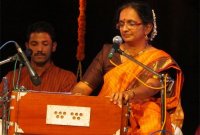
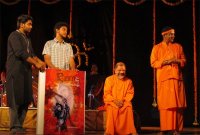
In a surprise move, Swami Tejomayananda joined the group on stage and
sang a keertana on Lord Rama. This was followed by the release of the
illustrated book ‘Nama Ramayana’ and an accompanying CD of hymns created
by Pramodini Rao. It was a novel idea when the giant book was opened to
reveal the CD and book inside it! The book presents 108 original
paintings of Valmiki Ramayana by young artist Arun Raman each
accompanied by a detailed narrative researched and written entirely by a
team of youth writers under Swami Mitrananda’s guidance. The artist was
woken up as early as 3am by swamiji to shower first and then get ready
to work on the illustrations, with each composition detailed by swamiji.
Each painting has been likened to a piece of meditation.
One did wonder how a flute recital would pay tribute to Rama but in
‘Nava Rasa to Rama Rasa,’ Hindustani flautist Himanshu Nanda and tabla
player Pt Kalinath Mishra had quite a few surprises in store. The moods
and bhavas of Ramayana put together with melody under the guidance of
composer Rajkumar Bharathi also had elements of theatrics! Rama and Sita
spot each other at the upavan and sringara rasa of love at first sight
was evocative in raag Basant. The breaking of Shiva’s bow in raag Durga
made for hasya rasa. Mandodari cries for the death of her family –
karuna rasa in raag Darbari. Ravana is angry when he loses his sons and
relatives in war – raudra rasa in raag Sohini. Vishwamitra wanted the
brave Rama and Lakshmana to protect his yagna – veera rasa in raag
Gambeeranattai. Trijata has a dream about Rama vanquishing Ravana –
bhayanaka rasa was special effects on tabla and eerie vocals by Mishra
and new sounds on the flute! The war field is full of dead bodies,
vultures preying on them – bhibatsa rasa had special effects on tabla
that brought out the battlefield on stage and a wailing flute that were
again greeted with rapturous applause. Water represents knowledge, cloud
represents noble person. Rama enjoys the beauty of nature – adbhuta
rasa in raag Miya ki Malhar. Rama pattabhishekam sees peace and
happiness in Ayodhya – shanta rasa in raag Bhairavi. In a surprise
treat, Balinese dancer Rahma Putra who had played Rama the earlier
evening, accompanied the melodious number with beautiful sinuous
movements. A lovely end to an innovative recital that had the audience
guessing every forthcoming rasa and raga with interest.
Click on thumbnails to view enlarged images
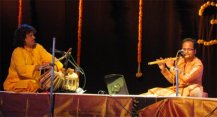
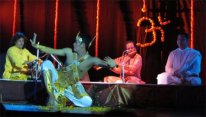
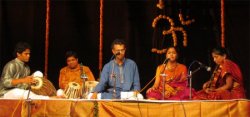
The final program of the evening ‘Sangeeta Maruti’ was a collection of 7
compositions by various composers directed by Rajkumar Bharathi
featuring a melodious Kritika Arvind on vocal, Karthik on mridangam,
Ganapathy on tabla and Srilakshmi on violin. Rajkumar Bharathi explained
each bhajan along with how the raga is used. The invocation “Anjani
maindaa potri” from Kamba Ramayanam was in raga Nattai. Arunachala
Kavi’s “Hanumane swamikkindha adayalam” is when Hanuman meets Sita in
the Ashokavanam and she gives him the choodamani to give Rama. “Kaluguna
padani raja seva” is a rare composition by Thyagaraja composed in rare
raga Poornalalitha, as if Lakshmana is addressing Hanuman. Next was
“Veera Hanumate namo namaha” by Muthuswamy Dikshitar. Kanaka Dasa’s
“Enna kanda halliya Hanuma” in Peelu ragam was followed by Purandara
Dasa’s “Hanumana mathave Hariya mathavu” in ragam Sumanesaranjini. The
recital ended with a bhajan “Vande santham sri Hanumantham” that had the
audience joining with full gusto.
The post performance discussion was moderated by Dr. Rama Kausalya,
director of Marapu Foundation, Thanjavur. She asked Pramodini Rao about
her selection of songs in her voyage with the vaggeyekaras through the
length and breadth of the nation! One song had been written by her
mother, some were known songs and she picked up a couple of songs from
You Tube! How did Himanshu Nanda zero in on the ragas for the rasas?
Since this was the first time he was trying out a theme based concert on
flute, Himanshu was guided by Rajkumar Bharathi who found translating
emotions into music interesting. But for bhayanaka and bhibatsa, one
would hardly be making music in fear or disgust, hence the special
effects! For Bharathi’s own presentation, to highlight the work of
different composers was of importance.
Ramaa Bharadvaj says the idea is to make this a traveling arts festival
so the artistic directors get to work with local talent and the city
chosen first for this was Chennai. So many Ramas in this festival…Lord
Rama, Ramaa Bharadvaj, Rama Kausalya, Arun Raman, Rahma Putra!
Lalitha Venkat is the content editor of www.narthaki.com
|





